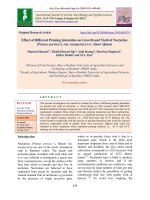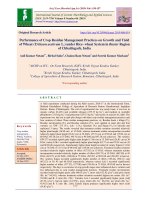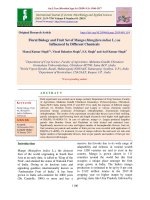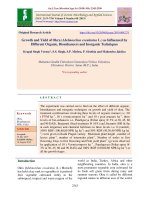Growth and yield of Ashwagandha [Withania somnifera (L.)] as influenced by different intercropping system in Kymore plateau of Madhya Pradesh
Bạn đang xem bản rút gọn của tài liệu. Xem và tải ngay bản đầy đủ của tài liệu tại đây (471.55 KB, 12 trang )
Int.J.Curr.Microbiol.App.Sci (2019) 8(4): 513-524
International Journal of Current Microbiology and Applied Sciences
ISSN: 2319-7706 Volume 8 Number 04 (2019)
Journal homepage:
Original Research Article
/>
Growth and Yield of Ashwagandha [Withania somnifera (L.)] as Influenced
by Different Intercropping System in Kymore Plateau of Madhya Pradesh
S.K. Ahirwar1*, K.K. Agrawal2 and H.S. Kushwaha3
1
Jawaharal Nehru Krishi Vishwa Vidhyalaya, Krishi Vigyan Kendra, Chhindwara
480 003 Madhya Pradesh, India
2
Department of Agronomy, College of Agriculture, Jawaharal Nehru Krishi Vishwa
Vidhyalaya, Jabalpur 480 004 Madhya Pradesh, India
3
Mahatma Gandhi Chitrakoot Gramodaya Vishvavidhyalaya, Chitrakoot, Satna,
485 334 Madhya Pradesh, India
*Corresponding author
ABSTRACT
Keywords
Intercropping
system,
Ashwagandha,
Oilseed and Pulses
Article Info
Accepted:
07 March 2019
Available Online:
10 April 2019
The experiment was conducted at the Research farm, Jawaharlal Nehru Krishi Vishwa
Vidhyalaya, Jabalpur (MP) during Kharif 2009 and 2011 with a view to study “Effect of
different intercropping system on growth and yield of ashwagandha [Withania somnifera
(L.)] in Kymore Plateau of Madhya Pradesh”. Showed that the plant height did not differ
between different treatments at early stage (30 DAS) but at maturity stage, it attained
significantly taller plants when intercropped with red gram during both years.
Ashwagandha at early (30 DAS) as well as maturity stage was almost unaffected by the
maximum branches 1.30 and 5.35 in ashwagandha grown with green gram (3:1). LAI was
not-significantly affected due to intercropping system with varied row ratio (3:1 and 4:1).
Though, it attained maximum 5.18 at 120 DAS. Plant dry weight was found at peak
growth period of ashwagandha viz. 60 and 120 DAS was significantly higher in
ashwagandha sole, Ashwagandha + red gram (3:1 and 4:1), Ahawagandha + niger (4:1).
The significantly produced higher root yields (518 kg/ha) over all other intercropped
stands producing tuber yields between 392 to 430 kg/ha. Amongst the intercropping
systems, ashwagandha grown with the sesame (4:1) gave the highest root yield of 430
kg/ha. Ashwagandha equivalent yield was recorded significantly maximum under
ashwagandha + red gram in 3:1 and 4:1 row proportion 6.27 and 6.25 kg/ha which
exhibited statistically at par with sole Ashwagandha (609 kg/ha).
and is a cross pollinated crop with
chromosome number of 2n = 48 (Nigam and
Kandalkar, 1995). It is grown mostly on
marginal lands of Neemuch and Mandsaur
districts of Madhya Pradesh and Kota,
Introduction
Ashwagandha [Withania somnifera (L.)] is
known as Indian ginseng, poison gooseberry
or winter cherry belongs to family Solanaceae
513
Int.J.Curr.Microbiol.App.Sci (2019) 8(4): 513-524
Jhalawar, Pratapgarh, Chittorgarh and Baran
districts of Rajasthan. It has an erect
branching under shrub reaching about 0.5- 1.0
m in height. The main active constituents of
ashwagandha plant are alkaloids and steroidal
lactones. The important chemical constituents
(Withanolides) are present in roots, leaf and
berries. The dried roots of ashwagandha have
been employed as valuable source of active
medicinal ingredients in Indian traditional
systems of medicine: Ayurveda, Siddha and
Unani. It forms essential constituent or whole
of 100 medicinal formulations of traditional
pharmacies like Ayurveda, Unani and Sidha
(Tuli and Sangwan, 2009). The roots of the
plant are categorized as rasayanas, functions
as a tonic for vitality and longevity (Singh et
al., 2010) and have been used as antioxidant,
adaptogen, aphrodisiac, liver tonic, antiinflammatory agent, astringent and more
recently to treat ulcers, bacterial infections,
venom toxins, senile dementia, hiccups,
bronchitis, rheumatism, dropsy, several
female disorders, stomach and lung
inflammation,
skin
diseases,
asthma,
emaciation, insomnia, neurological disorders,
Parkinson’s disease. Intercropping is the
production system which provides greater
yield on a given piece of land by making
more efficient utilizations of the available
growth resources using a mixture of crop of
different rooting ability, canopy, structure
height and nutrient requirement based on the
complementary utilization of the growth
resources by the component crop. Better use
of soil nutrients can be possible due to
difference in rooting pattern which may also
occur due to mutual avoidance of different
rooting system (Trenbath, 1974). With a view
to
study
different
intercrops
with
ashwagandha and its effect on growth and
yield, the following experiment was taken up.
Vishwa Vidhiyalaya, Jabalpur (MP) during
kharif of 2009 and 2011. The soil was clayloam with neutral reaction, low in organic
carbon (0.48 %), available nitrogen (230.2
kg/ha), medium in available phosphorus
(13.80 kg/ha) and high (371.70 kg/ha) in
available potassium. The rainfall received was
1471 and 1712 mm, in 43 and 59 rainy days,
the mean maximum and minimum
temperature were 310C and 30 0C and 19 0C
and 18 0C, the relative humidity ranged from
52 to 87 % and 55 to 61 % during two
respective
experimental
period.
The
component crops should invariably having
different growth rhythms and rooting patterns
were viz. red gram [Cajanus cajan (L)
Millspp], and green gram (Vigna radiata
Wilczek) as well as oilseed crops viz sesame
(Sesamum indicim (L), niger [Guizotia
abyssinica (L.F.)] and soybean (Glycine max
(L.) Merr.) used with ashwagandha under
Kymore Plateau of Madhya Pradesh.
The 11 treatments included viz. Ashwagandha
sole (T1), Ashwagandha + Red gram 3:1 rows
(T2), Ashwagandha + Green gram 3:1 rows
(T3), Ashwagandha + Soybean 3:1 rows (T4),
Ashwagandha + Sesame 3:1 rows (T5),
Ashwagandha + Niger 3:1 rows (T6),
Ashwagandha + Red gram 4:1 rows (T7),
Ashwagandha + Green gram 4:1 rows (T8),
Ashwagandha + Soybean 4:1 rows (T9),
Ashwagandha + Sesame 4:1 rows (T10) and
Ashwagandha + Niger 4:1 rows (T11)
combinations of four replications in RBD.
The variety and seed rate of Ashwagandha,
red gram, green gram, soybean, sesame and
niger were JA 134, 05 kg/ ha; ICPH 2671, 10
kg/ha; K-851, 25 kg/ha; JS 97-52, 50 kg/ha;
JTS 8, 02 kg/ha and JNC 1; 02, kg/ha,
respectively, with the spacing between sole
ashwagandha and intercrops 30 cm apart. The
seeds were sown on 26 June, 2009 and 30
June, 2011. The recommended dose of
fertilizers was 40 kg N + 20 kg P2O5 + 20 kg
K2O /ha for the Ashwagandha, sesame, and
niger, while it was 20 kg N + 60 Kg P2O5 + 20
Materials and Methods
The experiment was conducted at the
Research Farm of Jawaharlal Nehru Krishi
514
Int.J.Curr.Microbiol.App.Sci (2019) 8(4): 513-524
kg K2O/ha for red gram, green gram and
soybean. The fertilizer was applied as per
plant population of Ashwagandha and
component crops. Two irrigations were
applied in Ashwagandha and red gram due to
escape of rainfall in month of October during
the both years. The crops were harvested on
different date as per maturity. Those are
ashwagandha, red gram, green gram, soybean,
sesame and niger 27 Dec, 27 Nov, 29 Aug.,
15 Oct, 25, Dec, 20 Oct in 2009 and 28 Dec,
29 Nov, 30 Aug., 17 Oct, 27, Dec, 22 Oct in
2011, respectively. The Ashwagandha was
dug out by khurpi to protect the damage of
tuber.
This resulted in failure of the crops grown in
the field. Therefore, the experiment was
repeated next year i.e. 2011-12.
Data recorded on economic yields of various
crops on weight basis are not directly
comparable with each other. Therefore,
Ashwagandha equivalent yields (AEY) were
determined for all treatments to make them
comparable with each other. For this purpose,
the economic yields different associated crops
were converted in to Ashwagandha economic
yields on the basis of existing market value of
respective crop components. After this, the
converted AEY of associated crop of a
particular treatment was added with its
Ashwagandha yield realized as a main crop.
Finally, AEY values of all treatments were
used to compare the effect of the treatments.
The average annual average rainfall through
south- west monsoon for the last 20 years is
1350 mm with maximum concentration of
rains during July and August months coupled
with intermittent dry spells. The maximum
temperature reaches up to 45 0C during May
and June months,
while minimum
temperature goes down to the limit of 2 0C.
The relative humidity ranged between 90100% during rainy season, which changes as
60 to 70% and 30 to 40% during winter and
summer seasons, respectively. The weather
conditions viz. maximum and minimum
temperature, relative humidity, rainfall,
sunshine and wind velocity etc prevailed in
the locality during the period of investigation
were recorded from the Meteorological
Observatory
located
at
College
of
Agricultural Engineering, JNKVV, Jabalpur
(M.P.). The values are given in Figure 1, 2
and 3. It is obvious from the data on weather
conditions of the locality that there was
almost congenial conditions for the
germination, growth, development and yield
of crop (s) grown under the field experiments
during the year 2009-10. But there was high
rainfall with much rainy day and least
sunshine during the period (meteorological
weeks 28 to 32) of germination and an
establishment of crops in the year 2010-11.
AEY =
Yield of Ashwagandha +Seed Yield of
Intercrop (IC) kg/ha X Sale Price IC (Rs/kg)
------------------------------------------------------Sale Price of Ashwagandha (Rs/q)
Results and Discussion
Growth parameters
The data on various parameters given in table
1, indicated that plant height did not differ
significantly between different treatments at
early stage (30 DAS), but at maturity stage, it
attained significantly taller plants when
intercropped with red gram during both years
in consistent manner. Intercropping of
Ashwagandha + red gram resulted in the
significantly higher plant height of
Ashwagandha. However, sesame and niger
with ashwagandha also led to increase the
plant height of Ashwagandha, and treatment
was inconsistently significantly in both years.
Branches per plant of ashwagandha was
almost totally unaffected by introducing any
515
Int.J.Curr.Microbiol.App.Sci (2019) 8(4): 513-524
of the crops viz red gram, green gram,
soybean, sesame and niger over sole cropping
at early (30 DAS) as well as maturity stages.
The
number
of
branches/plant
of
Ashwagandha ranged from 1.17 to 1.28 and
5.18 to 5.35 between different intercropping
system at 30 DAS and maturity stages,
respectively. Growth parameters viz. plant
higher and number of branches of
Ashwagandha was recorded at early growth
and maturity stages, from the results it is
evident that plant height and branches/plant
did not differ with each other due to the effect
of different intercropping systems. The dry
matter of Ashwagandha under sole and with
some of intercrop was almost same or not
significantly influenced due to intercropping
system and varied row ratio. None of
intercrops grown with ashwagandha caused
any remarkable negative influence on
utilization of light and space by the
ashwagandha. Besides these, the nutrient and
moisture requirement of almost all intercrops
quite resembled to Ashwagandha. Therefore
above mentioned both growth parameter of
Ashwagandha in all intercropped stand were
on par to its sole stands. Similar opinion about
unaffected growth of Ashwagandha under
intercropping system in replacement series
have been reported by workers from their
studies. These findings are in accordance with
those of several workers (Willey, 1979,
Maurya and Rathi, 2000).
and niger with Ashwagandha in 3:1 as well as
4:1 row proportions did not show any
remarkable change in LAI values of
Ashwagandha over its sole stand at any of the
growth stages during both years of
investigation. Ashwagandha + red gram/ niger
recorded numerically higher LAI at all stages
of crop.
Dry weight of plants/m2
Dry matter accumulation by the ashwagandha
plants gradually increased at a steady rate up
to the maturity of the crop under all
treatments with the rapid rate increment after
90 DAS growth stage. There were significant
variations in dry matter accumulation by
Ashwagandha under different treatments. At
30 days stage, significantly superior dry
matter was noted in Ashwagandha + soybean
under both the row proportion (89 g/m2)
followed by sole Ashwagandha and
Ashwagandha + red gram (1:3 row ratio).
However, at 60 days stage, it was observed
significantly higher in Ashwagandha + green
gram (4:1) followed by sole Ashwagandha
and Ashwagandha + niger (4:1). Similarly, at
90 days, dry matter pattern was slightly
changed and it observed significantly greater
and same under Ashwagandha sole,
Ashwagandha + green gram (3:1),
Ashwagandha
+
sesame
(3:1)
and
Ashwagandha + niger (4:1) followed by
Ashwagandha + green gram (4:1). At 120
days stage, significantly maximum dry matter
was
noted
in
Ashwagandha
sole,
Ashwagandha + niger (4:1) and Ashwagandha
+ red gram. While at 150 days and at maturity
its dry matter accumulation was not varied
significantly due to intercropping and row
proportion pattern. It means growth of
Ashwagandha up to 90 days stage was
changed almost in same pattern under both
3:1 and 4:1 row proportions of intercrops.
Leaf area index (LAI), crop growth rate
(CGR), relative growth rate (RGR) and net
Leaf area index
Leaf area index (LAI) values successively
increased due to advancement in the growth
stages of crop up to 120 DAS (5.18) and then
it showed declining trend upto maturity stage.
It is also apparent from the data that rate of
increment in LAI values was most rapid
during the period between 60 DAS to 120
DAS and thereafter it slowed decline till the
maturity. Intercropping of companion crops
viz. red gram, green gram, soybean, sesame
516
Int.J.Curr.Microbiol.App.Sci (2019) 8(4): 513-524
assimilation rate (NAR) is known as growth
analysis parameters. Crop production is the
practical means of tapping solar energy
(sunlight) and converting it into food and
other useable material through the production
of leaves. The surface area of leaves per plant
is an important determinant in the production
of photosynthes suggested (Watson, 1952).
length varied from 12.18 to 13.08 cm and root
diameter from 2.60 to 2.89 cm at harvest
stage, of ashwagandha were augmented nonsignificantly due to ashwagandha grown alone
as well as intercropped with legumes and
oilseeds (Table 3). The other intercropping
treatment was resulted in non-significantly
lower values of root parameters. The
significantly higher values of root parameters
under Ashwagandha grown sole might be
owing to increased vegetative growth
including leaves surface or photosynthetic
area producing more photosynthesis for root
growth
and
shoot
development
of
ashwagandha. In comparison to other ten
intercrops, green gram legume crop benefitted
ashwagandha in several ways due to its better
compatibility with the main crop. The
variation in the development of roots and
shoots of different intercrops is governed by
their genetic architecture of parents. The
results corroborate with those of (Shrivastava
et al., 2004 and Lingaraja et al., 2008).
The maximum LAI was recorded in
Ashwagandha with red gram. This might be
owing to the better availability and utilization
of nutrients with presence of green gram and
thereby effective conversation of multi
nutrients at the site of photosynthesis into
pigments (Sanjutha et al., 2008). In fact most
favorable soil condition might have produced
maximum
photosynthetic
accumulation
towards leaf biomass, because during initial
stage, leaf is the most powerful sink than any
other plant parts in most of the crops (Table
2).
Yield attributing parameters
Productivity of Ashwagandha
Length of roots
Root yields
Length of roots of Ashwagandha was not
varied significantly due to intercropping
treatments. Root length varied from 12.20 to
13.20 cm during first year (2009-10) of
investigation, which were almost similar in
the next year (2011-12) as 12.15 to 13.00 cm
also. Based on two years mean data, the root
length ranged between 12.18 to13.08 cm.
Ashwagandha is mainly grown for its root
yields. It is evident from the data of table 3,
that root yields of Ashwagandha significantly
varied between different treatments in both
years of investigation as well as for mean
yields of both years. The trend of root yields
was almost similar in both years under
different treatments. Based on 2 years mean
data, sole crop of Ashwagandha significantly
produced higher root yields (518 kg/ha.) over
all other intercropped stands producing root
yields between 392 to 430 kg/ha. The
variations in root yields between different
intercropped stand were not significant, but
intercropping of all associate crops with
Ashwagandha in row proportions led to
record consistently higher root yields than
those obtained with respective associate crop
in 3:1 row proportion.
Diameter of roots
Diameter of roots of Ashwagandha as also did
not significantly differ with each other.
Though, the values of diameter of roots were
numerically greater in sole stand of crop over
its other intercropped stands. The values
pertaining to diameter of roots ranged
between 2.54 to 2.96 cm and 2.45 to 2.87 cm
in the two consecutive years of investigation.
On the basis of 2-year data, the mean root
517
Int.J.Curr.Microbiol.App.Sci (2019) 8(4): 513-524
Table.1 Plant height (cm.) and Number of branches of Ashwagandha as affected by different intercropping
systems (pooled data of 2 years)
Treatment
s
Number of branches
at 30 DAS
2009
2011
Mean
Number of branches
at Maturity
2009
2011
Mean
Plant height (cm.) at
30 DAS
2009
2011 Mean
Plant height (cm.)
at Maturity
2009
2011
Mean
T1
1.30
1.25
1.28
5.22
5.25
5.24
6.75
6.75
6.75
49.75
52.00
50.87
T2
1.25
1.20
1.23
5.30
5.25
5.28
6.25
6.25
6.25
56.75
51.50
54.13
T3
1.34
1.25
1.30
5.44
5.25
5.35
6.50
6.25
6.37
50.50
50.25
50.38
1.20
1.20
1.20
5.10
5.32
5.21
6.50
6.00
6.25
49.50
52.75
51.12
T5
1.15
1.25
1.20
5.20
5.30
5.25
6.25
6.25
6.25
47.25
48.00
47.62
T6
1.20
1.20
1.20
5.25
4.18
4.72
6.50
6.10
6.05
47.00
48.00
47.50
T7
1.10
1.25
1.18
5.15
5.25
5.20
6.25
6.25
6.25
53.75
54.75
54.25
T8
1.25
1.20
1.22
5.35
5.35
5.35
6.75
6.25
6.50
48.50
50.75
49.63
T9
1.15
1.20
1.17
5.25
5.32
5.29
6.50
6.50
6.50
49.00
50.00
49.50
T10
1.25
1.25
1.25
5.20
5.25
5.23
6.45
6.50
6.45
52.00
53.25
52.63
T11
1.15
1.25
1.20
5.15
5.20
5.18
5.25
5.25
5.25
51.00
52.75
51.87
SEm+
0.11
0.09
0.07
0.17
0.08
0.10
0.39
0.31
0.28
0.02
0.06
0.99
CD at 5%
NS
NS
NS
NS
NS
NS
NS
NS
NS
0.05
1.73
2.86
T4
Where, T1 (Ashwagandha (A) sole), T2 (A + Red gram 3:1 rows), T 3 (A+ Green gram 3:1 rows), T 4 (A+ Soybean 3:1 rows), T 5 (A + Sesame 3:1 rows), T 6 (A +
Niger 3:1 rows), T7 (A + Red gram 4:1 rows), T8 (A+ Green gram 4:1 rows), T 9 (A+ Soybean 4:1 rows), T 10 (A+ Sesame 4:1 rows), T 11 (A + Niger 4:1 rows).
518
Int.J.Curr.Microbiol.App.Sci (2019) 8(4): 513-524
Table.2 Physiological parameters of Ashwagandha under different intercropping
systems (Pooled for 2 years)
Tt.
T1
T2
T3
T4
T5
T6
T7
T8
T9
T10
T11
SEm+
CD 5%
30
DAS
60
DAS
LAI
90
120
DAS DAS
1.44
1.44
1.36
1.36
1.36
1.36
1.36
1.36
1.44
1.36
1.44
0.01
NS
2.80
2.88
2.72
2.72
2.72
2.80
2.72
2.72
2.80
2.72
2.88
0.02
NS
4.00
4.05
3.83
3.89
3.89
3.89
3.89
3.89
4.00
3.89
4.05
0.05
NS
5.18
5.18
4.98
5.02
4.98
5.05
5.02
4.98
5.12
5.02
5.18
0.05
NS
150 Maturity 0-30
DAS
DAS
Plant dry weight (g/m2)
30-60 60-90 90-120 120-150
DAS DAS
DAS
DAS
5.08
5.09
4.88
4.93
4.90
4.95
4.91
4.90
5.02
4.93
5.09
0.01
NS
190
184
189
187
184
187
184
191
188
186
190
0.40
1.16
4.99
5.02
4.80
4.86
4.83
4.88
4.83
4.82
4.94
4.85
5.01
0.02
NS
88
88
86
89
86
87
87
85
89
86
85
0.28
0.80
317
308
317
310
317
305
310
315
312
309
317
0.70
2.02
454
438
451
448
448
443
453
447
447
446
454
0.80
2.31
589
590
589
590
591
597
592
592
592
599
590
0.85
2.45
150
DAS
maturit
y
800
793
798
805
791
804
805
791
801
803
807
1.85
NS
Table.3 Growth and development of Ashwagandha under different intercropping systems
(Pooled for 2 years)
Tt.
Root length (cm)
Root diameter (cm)
Root yield (kg/ha)
AEY* (kg/ha)
2009
2011
Mean
2009
2011
Mean
2009
2011
Mean
2009
2011
Mean
T1
T2
T3
T4
T5
T6
T7
T8
T9
T10
T11
S Em ±
13.20
12.20
13.15
13.05
12.60
12.65
12.60
13.05
12.75
12.55
12.30
0.31
12.95
12.15
12.80
12.75
12.80
12.75
12.75
13.00
12.80
12.55
12.75
0.26
13.08
12.18
12.98
12.90
12.70
12.70
12.68
13.03
12.78
12.55
12.53
0.27
2.96
2.65
2.56
2.80
2.65
2.54
2.75
2.83
2.75
2.65
2.80
0.18
2.82
2.80
2.90
2.65
2.58
2.80
2.65
2.87
2.45
2.55
2.60
0.21
2.89
2.73
2.73
2.73
2.62
2.67
2.70
2.85
2.60
2.60
2.70
0.20
510
390
385
380
386
368
415
420
408
425
420
3.00
525
410
408
413
420
15
430
425
432
435
430
4.00
518
400
397
397
403
392
423
423
420
430
425
4.00
602
617
500
499
498
474
621
533
526
535
525
18
617
636
516
527
527
511
630
534
545
540
530
40
609
627
508
513
513
493
625
533
536
537
527
29
CD at 5%
NS
NS
NS
NS
NS
NS
9.00
12.00
* Ashwagandha Equivalent Yield
11.00
52
115
83
519
Int.J.Curr.Microbiol.App.Sci (2019) 8(4): 513-524
Fig.1 Weekly meteorological observations during the crop season from the year 2009-10
520
Int.J.Curr.Microbiol.App.Sci (2019) 8(4): 513-524
Fig.2 Weekly meteorological observations during the crop season from the year 2010-11
521
Int.J.Curr.Microbiol.App.Sci (2019) 8(4): 513-524
Fig.3 Weekly meteorological observations during the crop season from the year 2011-12
522
Int.J.Curr.Microbiol.App.Sci (2019) 8(4): 513-524
The root yields of Ashwagandha ranged
between 420 to 430 kg/ha in 4:1 row
proportions, while it ranged from 392 to 403
kg/ha in 3:1 row proportions. Root studies in
ashwagandha involve the yield attributing
parameters because it is a root crop used as a
medicine. In the present study range of root
length and root diameter were augmented
non-significantly due to Ashwagandha grown
alone as well as intercropped with legumes
and oilseeds. The findings corroborate with
those of Shrivastava et al., 2004 and
Lingaraja et al., 2008.
of ashwagandha intercropped with pulse and
oilseeds under 3:1 and 4:1 row ratios of
Ashwagandha + red gram was found most
productive system and AEYs it is under 3:1
(627 kg/ha) and 4:1 (625 kg/ha) which were
significantly superior to sole Ashwagandha
stand (609 kg/ha). Inter cropping of
Ashwagandha + red gram in 3:1 ratio was Rs
129760/ha, with BC ratio of 5.81 followed by
4:1 row ratio (Rs 129037/ha with BC ratio of
5.74) most profitable system in terms of
monetary return and benefit ratio for
sustainable production in Kymore Plateau
zone and other area having similar climate.
Ashwagandha Equivalent Yield (AEY)
References
The AEY significantly varied between
different intercropping treatments during both
years of investigation as well as mean of the
2-year data (Table 3). Based on mean data of
both years, Ashwagandha + red gram
intercropping system led to record AEY of
627 and 625 kg/ha in 3:1 and 4:1 row
proportion,
respectively
which
was
numerically higher than sole Ashwagandha
stand (609 kg/ha). The advantage of seed
yield of red gram replacing one row of
ashwagandha either of 3: 1 and 4:1 row
proved to be better than sole cropping of
ashwagandha as well as its intercropping with
pulse (green gram) and oilseed (soybean,
sesame and niger) crops. The mutual cooperation of ashwagandha and red gram for
their co-existence and higher market value of
red gram in the market appears to be possible
reason for its intercropping. The results are
also corroborated with the finding of several
other research workers (Patra et al., 1990,
Sarkar, Shit et al.,1990, Pannase and
Sharma 2009, Rout et al., 1990, Andrade et
al., 2001, Sunil Kumar et al., 2003,
Kurmvanshi and Rathore 2010 and Verma et
al., 2005).
Andrade, M. J. B. de, Morris, A. S. de,
Teixeria, I. R. and Silva, M. V. da.
2001. Evaluation of intercropping
system under beans and ashwagandha.
Indian Journal of Agronomy. 24 (14):
25-28.
Kirtivardha, V. and Ahirwar, S. K. 2009.
Effect of yield and economics of
Isabagol. International Journal of
Plant Archives. 15(2):280-283.
Kurmvanshi, S. M., and Rathore, L. (2010) A
study on productivity of redgram and
soybean, Agronomy and Research
approach. Field Crops. 29 (1&2): 7075.
Lingaraju, B. S., Merer, S. B. and
Chandrashekar, S. S. 2008. Studies on
intercropping of maize and pigeon pea
under rainfed conditions in Northern
Transitional Zone of Karnataka.
Karnataka Journal of Agricultural
Science, 21(1):1-3.
Maurya, B. M. and Rathi, K. S. 2000. Growth
and development of soybean as
influenced by intercropping with pigeon
pea and phosphorus level. GAU
Research Journal, 26(1):1-5.
Nigam, K. B., Kandalkar, V. S. 1995.
Ashwagandha
–
Advances
in
In conclusion, on the basis of two year data of
field experiment it is entered that productivity
523
Int.J.Curr.Microbiol.App.Sci (2019) 8(4): 513-524
Horticulture, Medicinal and Aromatic
plants. Malhorta Publishing House,
New Dheli, India. 11: 337-344.
Pannase S. and Sharma, R. S. 2009. Yield
and
economics
of
niger
in
intercropping system. Indian Journal
of Agronomy, 35: 122-120.
Rout, D., Pradhan, L., Barik, T. and Misra,
S. N. 1990. Studies on pure stand and
cereal legume association of maizesorghum cowpea and rice bean in
different
proportions.
Indian
Agriculturist, 34: 41-46.
Sanjutha, S., Subramaniam, S., Indu Rani, C.
and Maheshwari, J. 2008. Integrated
Nutrient Management in Angrographis
Peniculata. Research Journal of
Agricultural and Biological Science.
4.(2): 141-145.
Sarkar, R. M. and Shit, D. 1990. Effect of
intercropping cereals, pulses and
oilseeds with maize on production
competition and advantage. Indian
Agriculturist, 34: 88-89.
Shrivastava, G. K., Lakpale, R., Choubey,
N. K. and Singh, A. P. 2004.
Productivity and economics of pigeon
pea + urdbean intercropping system
under various planting geometry and
fertilizer management in rainfed
condition of Chhattisgarh. Indian
Journal of Agronomy, 49 (2): 101-103.
Singh G., Sharma, P. K., Dudhe, R. and
Singh, S. 2010. Biological activities of
Withania somnifera. Scholars Research
Library, 1:56e 63.
Sunil Kumar, Rawat, C. R. and Melkania, N.
P. 2003 Intercropping of forage
sorghum in pigeon pea under rainfed
conditions in semi-arid region. Range
Management and Agroforestry, 24 (2):
143-147.
Trenbath, B. R. 1974. Biomass productivity
of mixtures. Advances in Agronomy,
26: 177-206.
Tuli, R. and Sangwan, R. S. 2009.
Ashwagandha a model Indian medicinal
plant‖. Council of Scientific and
Industrial Research (CSIR), New Delhi.
Verma, S. S, Joshi, Y. P. and Saxena, S. C.
2005. Effect of row ratio of fodder
sorghum in pigeon pea intercropping
system on productivity, competition
functions and economics under rainfed
conditions of north India. Indian
Journal of Agronomy,50: 123-125.
Watson, D. J. 1952. Physiological basis of
variation in yield. Advances in
Agronomy, 4:101-145.
Willey, R. W. 1979. Intercropping, its
importance and research needs part 2.
Agronomy and Research approach.
Field Crops Abstract, 32 (1&2): 1-10
and 73-85.
Yadav, M. K, Kushal, P. L. and Khurana, S.
L. 2011. Effect of intercropping of
pulses and oilseeds with Ashwagandha
on production. Indian Agriculturist,
19:18-20.
How to cite this article:
Ahirwar, S.K., K.K. Agrawal and Kushwaha, H.S. 2019. Growth and Yield of Ashwagandha
[Withania somnifera (L.)] as Influenced by Different Intercropping System in Kymore Plateau
of Madhya Pradesh. Int.J.Curr.Microbiol.App.Sci. 8(04): 513-524.
doi: />
524
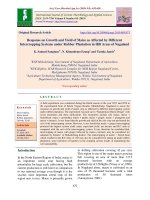
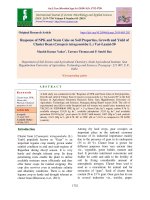
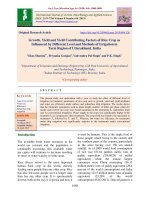
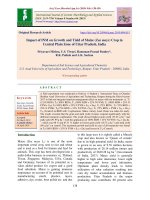
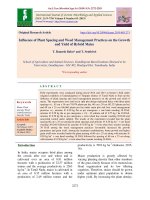
![Growth and yield of Ashwagandha [Withania somnifera (L.)] as influenced by different intercropping system in Kymore plateau of Madhya Pradesh](https://media.store123doc.com/images/document/2020_01/09/medium_vsb1578562778.jpg)
